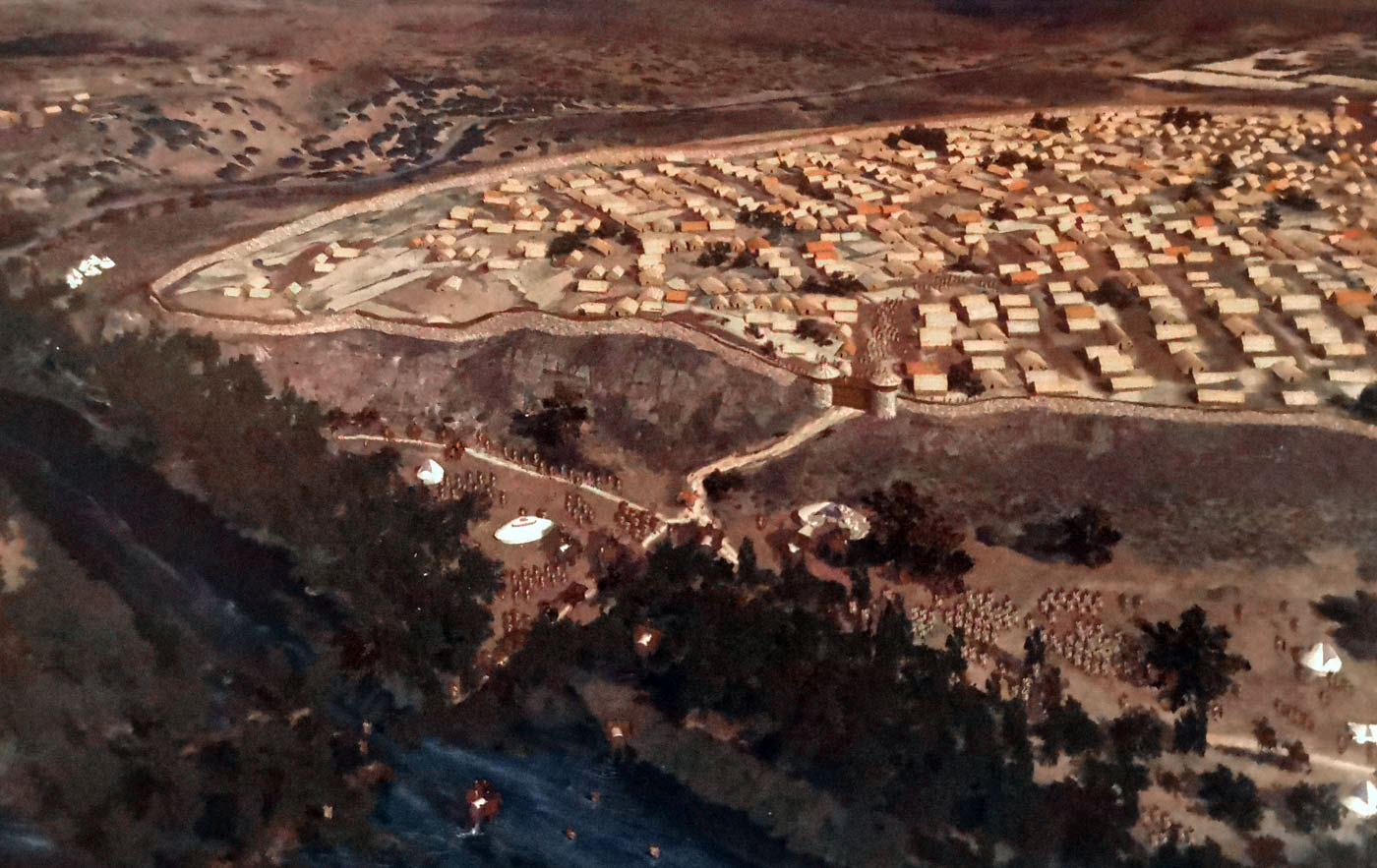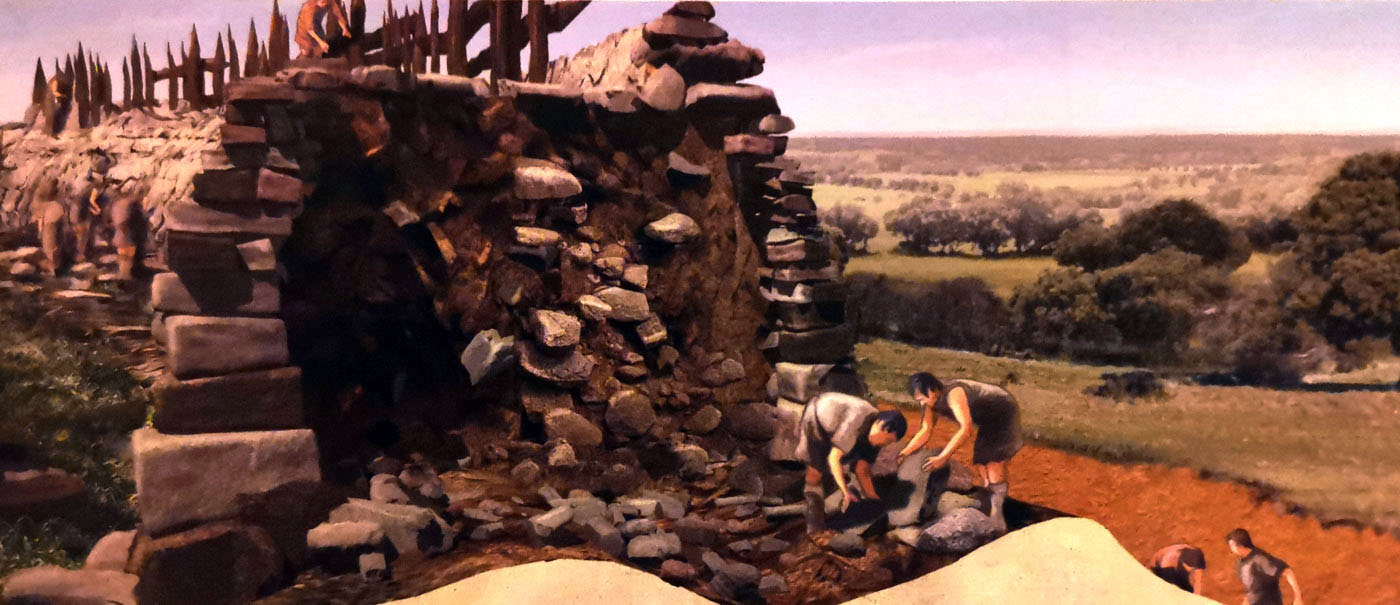THE WALLS, GUARDIANS OF HISTORY
The Interpretation Center of the Walls of Salamanca, called ‘Salmantica Sedes Antigua Castrorum,’ offers a journey through the city’s history, highlighting the importance of its walls as more than mere defensive structures. They represent the strength and resilience of Salamanca through the centuries, from its prehistoric, Roman, and medieval past. In this center, the stones of the walls come to life, telling stories of battles, conquests, taxes, and community, reminding us that time is an infinite cycle in the universe of history.
Salamanca is a city with a rich heritage and a complex history, evidenced by its multiple walls built at different historical moments. From the first foundations on the Cerro de San Vicente to the ‘Cerca Nueva’ of 1147, each wall design tells its own story. These structures have witnessed the city’s evolution, reflecting its growth and adaptation through the centuries. The walls not only served for defense but also marked the heart of an expanding community.
The walls of Salamanca, built with granite and sandstone, are a lasting testament to the city’s history. The original builders, whose identities have been lost to time, left a legacy that endures in every stone placed. Walking alongside these walls is like strolling through an open-air museum, where each stone has a story to tell. The walls delineated life inside and outside the city, and their presence today invites us to reflect on the past and the constant change of Salamanca.
The walls of Salamanca reflect the city's evolution, from its pre-Roman origins to its medieval expansion. These inert stones narrate the lives of diverse societies and cultures that found protection and survival within them through the centuries. More than mere defensive structures, the walls symbolize the shelter and resilience of the Salamancan community, marking territorial boundaries, facilitating fiscal and transit control, and reinforcing the identity and cohesion of its inhabitants.
The archaeology of these walls reveals layers of conflicts, defensive strategies, and sociopolitical changes, interpreting their economic and symbolic functions as a material discourse. Different cultures, from the Soto de Medinilla Culture in the 8th century BC to the order of Alfonso VII in 1147, left their mark on these fortifications. Using various techniques and materials, the walls reflect the defensive and aesthetic needs of each era. The width of the walls, ranging from 1 to 7 meters, and the use of recycled materials, such as Roman stelae, highlight the architectural adaptability and evolution of the city.
Over time, the walls of Salamanca have experienced collapses and transformations. In the 20th century, significant sections such as the Puerta de San Pablo crumbled, and urban development integrated remnants into new constructions like the Casa Lis. Despite this, the walls have been protected and recognized as a Site of Cultural Interest under the 1985 Spanish Historical Heritage Law, preserving their legacy as a symbol of Salamancan history and culture.
ROOTS OF GRANITE:
THE HISTORY OF THE WALLS
WHO BUILT THEM?
The first of them was carried out by the so-called Soto de Medinilla Culture, around the mid-7th century BC, until the early 6th century BC. Subsequently, protohistoric groups living in the Teso de las Catedrales became prominent in the construction of a defensive wall. Specifically, Romans and medieval groups who lived there also contributed to its construction. This pre-Roman Castro wall is an imposing defense ranging between 3.5 and 7 meters in width.
The settlement where this monumental defense stands dates back to the 4th century BC, though it underwent changes until at least the 12th century. It is noteworthy that during prehistoric times, additional defensive systems such as ditches or standing stones were also implemented. Finally, in 1147, Alfonso VII ordered the construction of a wall, a task he entrusted to his brother-in-law, Raymond of Burgundy.

HOW WERE THEY BUILT?
The inhabitants of Salamanca opted to use typical techniques of the time and materials available in the area, primarily clay and shards of slate, especially for the first of the walls, in the 7th century BC. The second was constructed with trimmed local stones, although it is challenging to determine precisely due to extensive repairs. Nonetheless, it appears evident that its interior was filled with gravel and earth of various origins. Later, during the Roman era, irregular masonry was introduced, but with six courses of opus quadratum blocks and small granite blocks. In the medieval period, stones of various origins were used.

WHAT WERE THEIR GATES LIKE?
In the case of the first wall, it is likely that it had entrances protected by sturdy wooden gates, essential elements for security and access control.
During the period known as the “Cerca Vieja,” the distribution of gates varied by direction. In the south, notable gates included Alcázar, Postigo Ciego, and del Río. Towards the east was the gate of San Sebastián, and in the north was del Sol, reflecting a defensive organization that catered to the needs and characteristics of each sector.
With the construction of the “Cerca Nueva” in 1147, the access scheme expanded and diversified similarly to the wall itself. To the south, gates like San Lorenzo, San Polo, and the New Gate or del Sol or del Espolón were added, alongside existing ones like Alcázar, Postigo Ciego, and del Río. In the east, gates such as Santo Tomás and San Cristóbal or Sancti Spiritus were included. Gates in the north evolved to include Toro or Zamora, and in the west, gates like Villamayor, San Francisco or San Bernardo, as well as San Clemente or San Hilario or Falsa and San Vicente, were integrated, thus delineating a more complex perimeter adapted to the new defensive and urban management requirements of the time.
ELEPHANTS
IN SALAMANCA?
In the first light of dawn, the silhouette of Hannibal’s elephants stood out against the reddish sky, marking the beginning of an era in which war would change its course. Hannibal, the Carthaginian leader, had led these majestic beasts across the Alps, and their arrival on the Iberian Peninsula foreshadowed a significant change. As they entered Salamanca, the inhabitants, both fascinated and fearful, gazed upon these enormous and powerful animals. Hannibal used his elephants not only as war machines but also as instruments of deterrence, parading the creatures in formation to intimidate and persuade local leaders to negotiate rather than fight.
The resilience and cunning of the elephants became a source of inspiration among the Carthaginians, especially during the difficult crossing of the Alps. In Salamanca, the presence of the elephants resonated in every corner, and their impact was deeply felt. Children followed the beasts from afar, creating legends about the Carthaginian leader and his four-legged companions. Hannibal found in Salamanca not only a terrain for conquest but also a place to sow the myth of his invincibility. As they departed, the elephants left indelible imprints on the land and in the memories of those who witnessed them, becoming legends told and retold about the giant of Carthage.

SALMANTICA SEDES
ANTIGUA CASTRORUM_
The Interpretation Center offers an immersive experience to explore the history of Salamanca through its walls. From the consolidated remains of the pre-Roman wall to the medieval enclosure, the architectural evolution and military events that shaped the city are recounted, including the arrival of Hannibal in 200 BC and the Battle of Salamanca during the War of Independence. Through infographics, audiovisual presentations, and interactive displays, these historical moments are contextualized, complemented by reproductions of archaeological materials linked to the pre-Roman wall.
OPENING HOURS_
Friday: 5:00 p.m. to 8:00 p.m. | Saturday, Sunday and Public Holidays: 10:00 a.m. to 2:00 p.m. and 5:00 p.m. to 8:00 p.m.
Free admission
FAMILY ACTIVITY_
“Become an Archaeologist”
Thursdays and Fridays: 11:30 a.m. to 1:30 p.m.
Free admission
Note: Schedules and conditions are subject to change. It is recommended to check the updated information on salamancaymas.es before attending.
ACCESSIBILITY_

When twilight kisses the stones, one can hear the echo of ancient voices narrating battles won and lost, forbidden loves in the shadows of the bastions, and the clamor of merchants on market days. The wall of Salamanca is not just a physical barrier, but a bridge between generations, a canvas that illustrates a rich human history.
PLAN DE SOSTENIBILIDAD TURÍSTICA DE SALAMANCA










